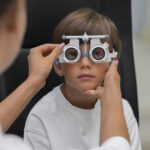Hello parents, in this blog let’s talk about children’s eye exams to keep those precious little eyes in tip-top shape.
Why Eye Exams Matter?
Children’s eyes are constantly developing, changing in shape. Regular eye exams can catch issues early when they’re most treatable, ensuring optimal visual development and higher quality life both within and outside school. Research backs this up. A study published in the Journal of American Association for Pediatric Ophthalmology and Strabismus found that undetected vision problems can significantly impact a child’s learning and social development.
How Often Should Your Little One Get Checked?
Taking your child to the doctor in any situation can be stressful. However, when it comes to eyes, prevention is critical.
- Ages 3-5: At least one comprehensive eye exam before starting school.
- Ages 6-12: Every two years if no vision correction is needed. Annually, otherwise.
- Ages 13+: Every one to two years, depending on the child’s vision needs.
Remember, these are general guidelines. Consult your doctor to determine what is right for your little one. In most European countries, including the Netherlands, eye exams for children are free of cost.
Common Eye Issues in Kids
Here are some common culprits:
- Myopia (Nearsightedness): When distant objects look blurry.
- Hyperopia (Farsightedness): When close-up objects are blurry.
- Astigmatism: When the cornea isn’t perfectly round, it blurs both near and far objects.
- Amblyopia (Lazy Eye): When one eye doesn’t develop normal vision.
Interestingly, some eye conditions can be more prevalent in certain ethnic groups. For instance, myopia is more common in Asian children. However, remember that any child can develop any eye condition, regardless of ethnicity or genetics.
Signs Your Child Might Need an Eye Exam
Keep an eye out (pun intended) for these signs that your child might need an eye exam:
- Squinting or closing one eye
- Frequent eye rubbing or blinking
- Holding books or devices too close to the face
- Complaining of headaches or eye strain
- Difficulty concentrating on schoolwork
You should also check with their teacher at the school or daycare if they notice any of these above symptoms. If you even suspect any issue, book an eye exam immediately. It’s better to be safe than sorry.
Why Early Detection Matters?
Untreated eye issues can have long-lasting effects. They lead to learning difficulties, reduced sports performance, and, in certain cases, even partial or complete vision loss. Apart from the physical effects, it can also have an impact on the mental well being. A study in the Journal of AAPOS found that children with untreated amblyopia had significantly lower self-esteem and quality of life compared to their peers. So, a timely eye checkup can help catch and treat problems and set your child up for success in all areas of life!
Vision is one of the best gifts nature gives us. As parents, we are the guardians of our child’s eyesight. Regular eye exams are a small investment in your child’s future, ensuring they have the clear vision needed to learn, play, and grow confidently.
Additional Resources
- American Academy of Ophthalmology: www.aao.org
- American Optometric Association: www.aoa.org
- National Eye Institute: www.nei.nih.gov
- Children’s Eye Foundation: www.childrenseyefoundation.org
Join Our Community!
Stay updated and swap tips with other parents by joining our WhatsApp group. Share this post with fellow parents and invite them to join too. Together, let’s keep our kids’ precious little eyes healthy.




